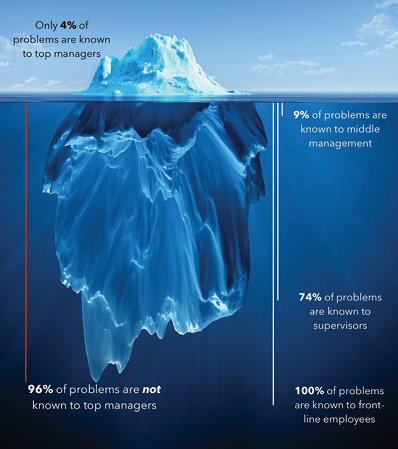The Iceberg of Ignorance
In his acclaimed study “The Iceberg of Ignorance”, consultant Sidney Yoshida concluded: “Only 4% of an organization’s front line problems are known by top management, 9% are known by middle management, 74% by supervisors and 100% by employees…”
Based on the 2015 Thinkpoints Transformation survey, the knowledge gap for leaders is pretty large in a couple areas that a CEO or executive should care about.
61% of respondents who identified as Executive or General Management (20% of all respondents) agreed their organization had “efficient, effective processes with minimal waste and bureaucracy”. But only 27% of all other respondents agreed with that statement.

Here’s another result. While 65% of Executive or General Management respondents say their organization “works seamlessly across departmental lines to achieve common goals”, only 29% of everyone else in their organization agrees with that.
Those large gaps should be a concern to anyone in executive or general management. It reveals an important disconnect between a leader and his or her organization that can lead to employee disengagement, organizational frustration and poor business performance.
But the conventional approaches to closing these gaps –restructuring, reorganizing, process redesigns, transformations, or continuous improvement programs– have largely failed to make a difference. In fact, conventional approaches fail over 70% of the time.
So, a different approach is needed. One that addresses the real issues holding back better performance.
Although the Yoshida study involved numerous mid-sized organizations, the basic findings tend to be the same in organizations of any size. The 1-2-3 process of decision-making is a proven way for leaders to tackle this problem of organizational ignorance.
1-2-3 Defined
1-2-3 says that before anybody decides anything (and even before thinking of preliminary decisions regarding your challenges and opportunities), three key questions should be asked. They are:
- Who can help me make a better decision?
- Who will have to carry it out? and
- Who will be impacted by it?
These people (or representatives of their groups) should then be brought together to discuss the situation and the most beneficial actions to pursue. Every leader can have a more successful business planning process by melting three limits of the Iceberg of Ignorance and a 3rd party Operational Diagnostic can support this.
Melting the Ignorance in Your Organization
People making strategic plans, deciding on budgetary allocations, reviewing benefit plans, etc., need all the input they can get to make the best, informed decisions. Can employees on the front-line, supervisors and middle managers provide important information to aid planning and decision-making? Without a doubt! If nothing else, they can bring front-and-center all the knowledge they have of problems in the organization to which senior managers are blind. Often, if they remain unknown to management, these problems impede the implementation or diminish the results of even the best-laid plans.
Melting Obstacles to Implementation
Will employees on the front-line, supervisors and middle managers have to carry out decisions made by those who do the planning? Of course they will! And who are better positioned than they to know what kinds of things might get in the way of implementing decisions that are made and plans that are laid? Bringing them into the process and listening to their input will grease the skids for implementation of the decisions and plans.
Melting Resistance to the Impact
Instead of feeling like they are “just a front-line employee or front-line manager”, if their thoughts and ideas are solicited, employees will more likely see themselves as full-fledged members of an outstanding team and they will be prepared to weather the impact of decisions and plans. Once again, better information and enhanced inspiration through employee involvement in decision-making is critical. How does your organization avoid The Iceberg of Ignorance?
How can the Engine Room provide value to you?
1. The Engine Room Operational Diagnostic
The Operational Diagnostic identifies, measures, and assesses the specific root causes of challenges affecting all aspects of operational performance and compliance. The methodology is predicated on the belief that meaningful performance occurs when the combination of strategy, process, leadership, systems, and execution all converge. Consequently, the diagnostic evaluates the range of characteristics required to elevate performance – supporting rapid development and providing senior leadership with specific recommendations.
Support in the diagnostic phase involves:
- Interpreting and evaluating diagnostic results related to:
- Clarity and support for business goals and objectives
- Leadership alignment and managerial capability
- The ef
Subscriber Access
Unlock Deeper Insights with The Engine Room
Join our community and gain exclusive access to our newsletter, full insights, thought leadership, and expert perspectives that shape our approach and principles. Dive deeper into the strategies that drive high-performing teams, leadership excellence, and operational success.
Sign up today to stay ahead with actionable knowledge designed to elevate your impact along with your organization and team.






